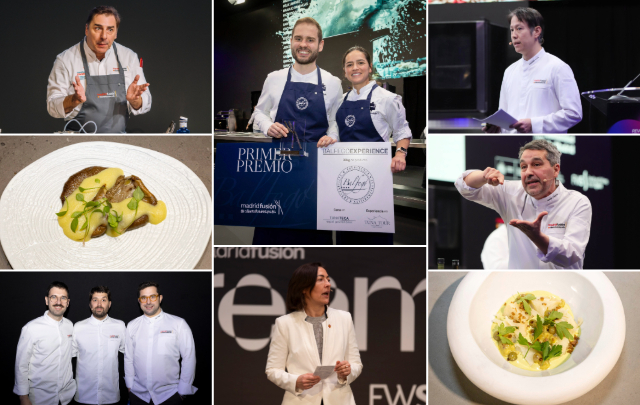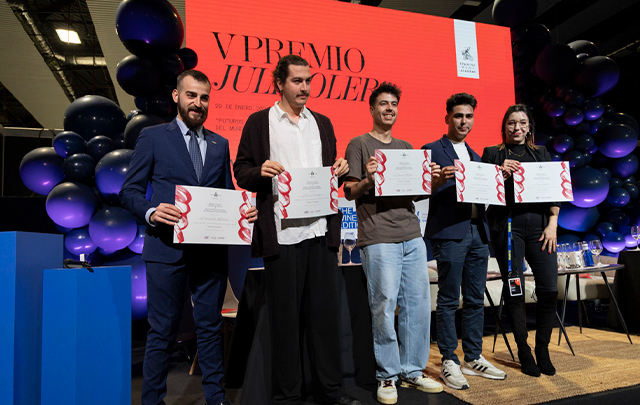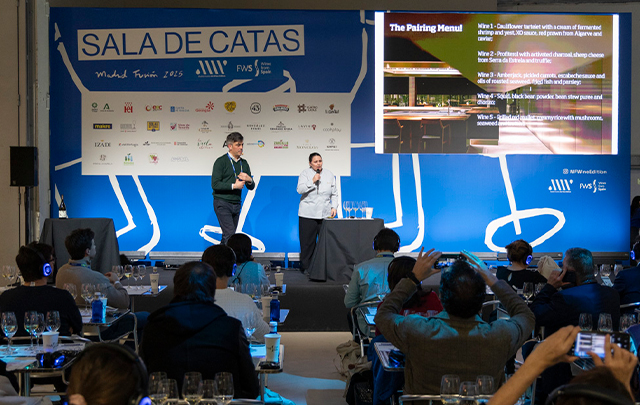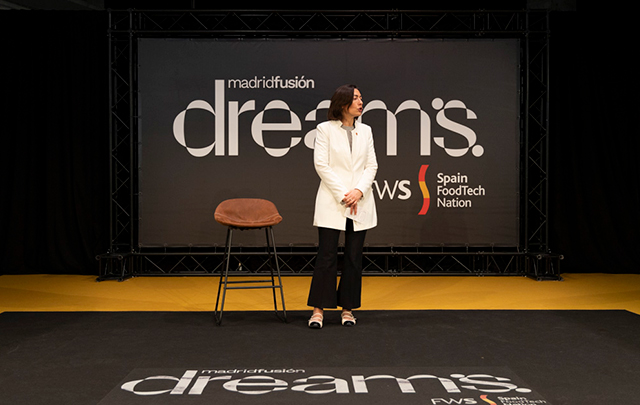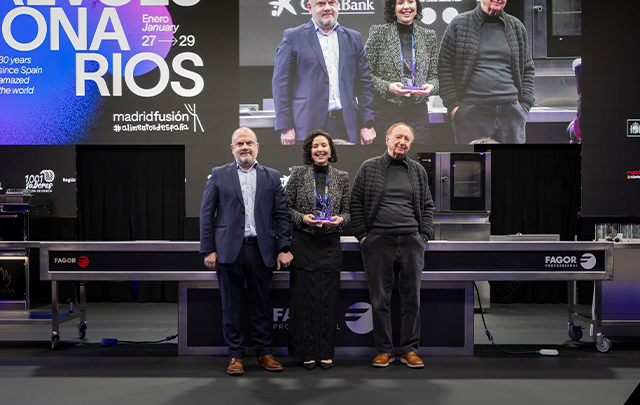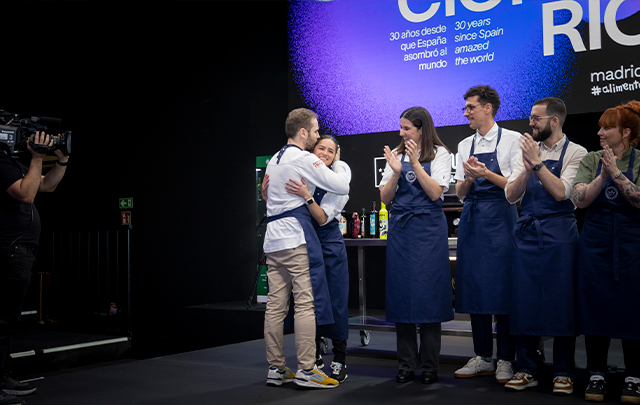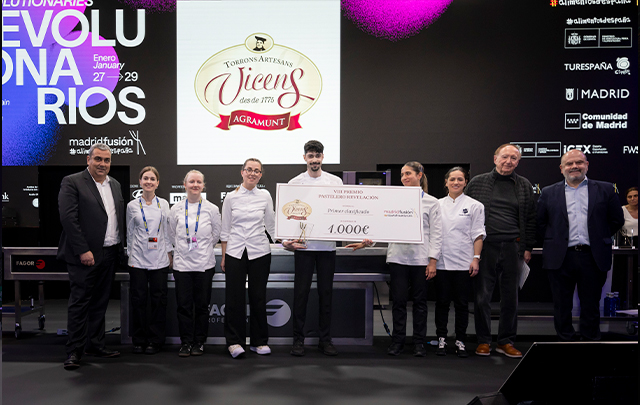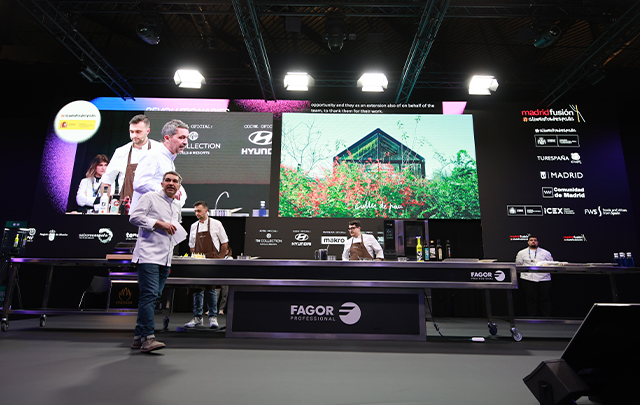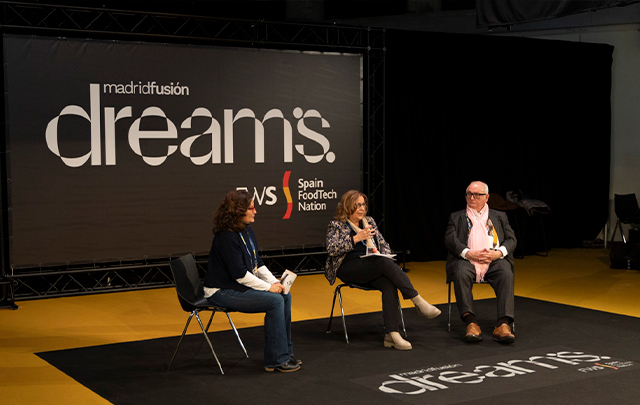News
Volcanic character, the revival of aligoté and the gastronomic versatility of natural wines on the first day of Madrid Fusión The Wine Edition 2025
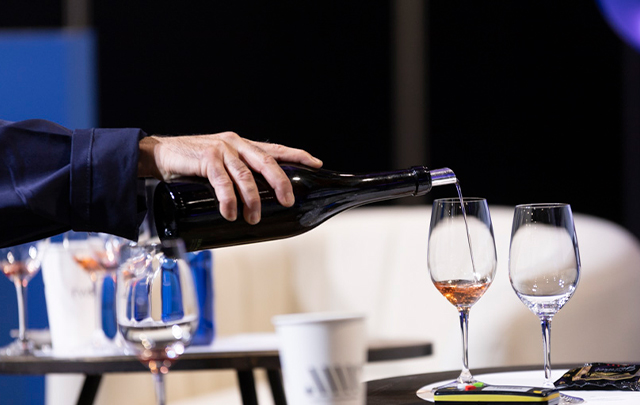
In this master class, which opened the sessions of the great Madrid Fusión Wine Congress, Cavero was accompanied by some of the world's most important producers of volcanic wines: Jonatan García Lima, Suertes del Marqués, Tenerife; Angeliki Karakosta, Hatzidaki, Santorini; and Antonio Maçanita, Azores.
Karakosta explained that Hatzidaki's wines, which come from hand-planted, basket-shaped vineyards, reflect the complexity of the volcanic soil, resulting in very mineral, high-acid wines that are characteristic of this Greek island. We age our wines in the traditional way, in the depths of a cave dug out of the earth," he says.
You have to be a little crazy to make wine in the islands," says Antonio Maçanita, explaining his project in the Azores (Portugal). The conditions for making wine on the island of Pico are extreme: volcanic soil, very close to the sea, maritime influence on viticulture, strong winds and a very cool climate with a lot of rain. "We have to protect the vineyards with walls that we call currais, or corrals," he says. Heroic viticulture that produces very salty and mineral wines that show all the uniqueness of indigenous varieties like Arinto dos Açores. "Terroir is not what we have, but what we lack," he says.
Back in Spain, Jonatan García Lima from the Canary Islands pointed out the diversity of the islands' wines, which is favored by the distance between the islands and their geological origins. There are many types of volcanic soils, acidics depending on their age, which have a direct impact on the character and differentiation of our wines; the same goes for whether the vineyards face north or south, not to mention the rainfall," he pointed out. The oenologist from Suertes del Marqués in Tenerife also highlighted the problem of drought and heat waves: "We will have to adapt to climate change by looking for higher ground. And he spoke of the importance of the braided cordon system typical of La Orotava in resisting extreme weather conditions and protecting the vineyard from pests such as phylloxera. Reductions are not always associated with the volcanic character, with the so-called 'volcanism', in my opinion the volcanic personality can be summed up in salinity and freshness," García Lima concluded.
Brand building, communication and transmission was the focus chosen by Ferran Centelles for the first theoretical session on Monday. Accompanied by Gabriel García de Oro, an expert in emotional storytelling, and Elisa Errea, CEO of The Wine Studio and member of the advisory board of Madrid Fusión the Wine Edition, the former elBulli sommelier gave practical examples of how to apply the basic concepts of storytelling to the world of wine.
We sommeliers have trouble talking about wine with emotion," says Centelles. When we present wines, we give information about how they are made, their grape varieties and their aromas. And this information is often not very appealing, we don't connect with the customer. How can we talk about wines in a more emotional way? García de Oro answered the question with a statement: "Humans are narrative creatures, we love stories, and we function on the basis of stories."
"Communication is the common ground created when I say what I want to say and you feel involved," added the expert in emotional storytelling. "When we listen to a story, we project ourselves into it, and stories produce results. Belonging (what I tell myself), connection (what I tell to the outside world), adaptation (what the world tells me), and reputation (what others say about me) are the four possible outcomes that stories produce.
When a sommelier wants to tell a story about a wine in a restaurant, Gabriel García de Oro advised, he should ask himself three questions: What do I want them to know? What do I want them to feel? What do I want them to do? The great power of stories is that they connect us emotionally, and to do that, you must move the customer, get them excited. If we know what we want to say and what we want to achieve, we will be better able to develop our story to connect.
Understanding emotions is also fundamental to communication. During the theoretical session, the expert stressed that "if we want to be good storytellers, we have to be skilled in emotional intelligence". Elisa Errea concluded the session: Storytelling is a tool for life.
The surprise of the day came from Mohamed Benabdallah, a sommelier at Etxebarri*, who organized a tasting of Aligoté, the forgotten white grape of Burgundy. It is a grape that has historically been undervalued because of its acidity, always behind the queen of Chardonnay; it was the house wine of the restaurant staff, it was used to mix with cream de cassis to make kir and few wineries bottled it as a single variety," he said.
The sommelier introduced this French variety through a selection of wines that aim to restore its lost dignity. Aligoté used to have a bad image because until the 1990s it was planted in very fertile soils with high production, quantity over quality. Today it is a very sought-after grape because Chardonnay is unaffordable in Burgundy," he said. At the moment, anything with the word Burgundy on it immediately goes up in price.
Aligoté wines tend to be light and acidic, unlike the better-known Burgundy whites based on Chardonnay. "With climate change, Aligoté has found its place," the sommelier argued. By tasting eight wines from both Burgundy and the New World, attendees were able to understand the versatility of a very different varietal and its place in today's market. From natural labels with more contemporary profiles to classically styled wines closer to the aristocracy of Burgundy and the Chardonnay style.
Natural wines and non-alcoholic options
As usual, the Vinomios will offer unique culinary experiences at lunchtime, where renowned chefs and their kitchen teams will give joint demonstrations, allowing visitors to enjoy exquisite combinations of wine and food.
Rafa Peña, chef and co-owner of Gresca, and Alberto Segade, sommelier and head waiter at Kadeau**, organized the first Vinomio of this edition. A pairing that aroused particular interest among the participants, as it gives voice to the trend of natural wines, based on a selection of references with a lot of personality, mostly made by women, from different parts of the world. Natural wines that stand out for their delicacy and elegance, as well as their ability to harmonize with all types of food.
With natural wines, it all depends on how open you are to the game," the chef argued. "They are artisanal wines, less technically adjusted, but very defined by freshness and very interesting when it comes to creating harmonies." For his part, the sommelier pointed out that "it is a mistake to talk about natural wines, there are bad wines or good wines, although the latter tend to have more beautiful stories behind them, of sustainability and respect for their environment. Light reds, whites and rosés from places as diverse as Mallorca, the Rhone, the Penedès and Burgundy, made with care and without additives, are the wines that represent this category in gastronomy. Lighter drinks go better with food than stronger ones," adds Peña.
Henrietta Lovell of the Rare Tea Company opened the afternoon session in the Wine Hall with one of the most eagerly anticipated tastings of the fifth edition of The Wine Edition Wines from Spain. Non-alcoholic pairings, a tasting that highlighted the topicality and versatility of an alternative that is increasingly in demand by those seeking to reconcile gastronomy and health.
The expert demonstrated how tea can be a pairing ally in several scenarios. If you're going to a restaurant or out with friends and you don't want to drink alcohol, you have to choose between fizzy water, a soft drink or at most a mocktail, which are really boring options," said Lovell. Tea offers us a new way to socialize without alcohol, as a drink, served cold and in a wine glass, or as a base for creating other, more complex drinks.
Henrietta Lovell creates tea pairings for some of the world's finest restaurants, based on her own discoveries while visiting organic farms around the world. We can make connections between white wine and green tea, from the terroir to the aromatic nuances, the production, the producers, the locations, and ultimately the experiences," she explains. There are teas that go very well with sushi and others that go particularly well with chocolate.
Tea as an expression of a place, a philosophy of artisanal and sustainable work that has nothing to do with industrial production. A non-alcoholic alternative to wine that is simple, healthy and easy to control. The best thing about tea is that you can change the complexity and strength of the aromas and flavors by varying the preparation or serving temperature, something you can't do with wine," she argued.
Finnish tradition
The first day of The Wine Edition Wines from Spain concluded with a journey into Finnish drinking culture, its history, development and new discoveries, led by sommelier and hotelier Samuil Angelov, CEO of Muru Dining and Vice President of the Finnish Sommelier Association.
Helsinki is having a very good time in terms of gastronomy, there is a lot of life in the restaurants and a deep-rooted sustainable conscience," says Angelov. "When it comes to drinking, the most traditional things in Finland are beer, fermented red fruits and, of course, spirits. The clean, pure water in this part of the world plays a fundamental role in the production of all these drinks.
We are not wine producers, our vineyard is the forest, we are forest and water, but that makes us open to wines from all over the world. This is how the sommelier explained the origin of the Finnish tradition of making "red fruit wines".
The tasting included some of the most awarded Finnish wines in the world. Fermented from wild strawberries, blackberries or blueberries, made in the style of traditional white and red wines, even following the line of orange wines, with low alcohol content and sometimes aged, showing once again that the world of wine goes beyond grapes and vineyards. A fascinating and very interesting contribution to the art of pairing for restaurants that want to play with new flavors to harmonize their dishes.

